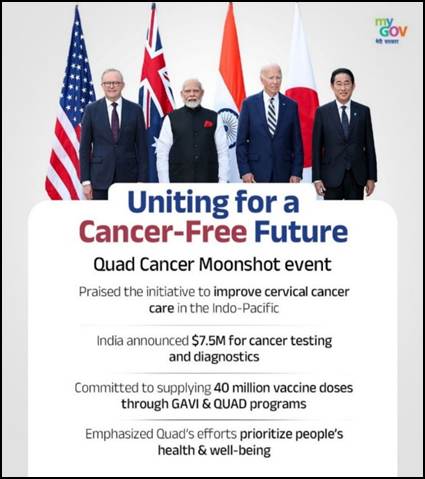India’s Cancer Burden

- 04 Sep 2025
In News:
Cancer has emerged as one of India’s most pressing public health challenges. Globally, in 2022, nearly 20 million new cases and 9.7 million deaths were recorded. In India, cancer incidence is rising sharply: in 2023, more than 14 lakh new cases were reported, and in 2024, 15.6 lakh cases with 8.74 lakh deaths were registered. The lifetime risk of developing cancer in India is now 11%, making cancer control a critical priority for health policy, infrastructure, and research.
Trends in India’s Cancer Burden
The National Cancer Registry Programme (NCRP), based on 43 population-based registries across 23 states and UTs, has mapped incidence and mortality patterns. Between 2015–2019, 7.08 lakh cancer cases and 2.06 lakh deaths were recorded.
- Gender Disparities: Women account for 51% of cases but only 45% of deaths, as breast and cervical cancers—the most common among women—are more detectable and treatable. Men suffer higher mortality due to difficult-to-diagnose cancers like lung and gastric cancer.
- Oral Cancer Surge: Oral cancer has overtaken lung cancer as the most common among men, despite a decline in tobacco use, due to latency effects and risk multipliers like alcohol.
- Regional Hotspots: The Northeast, especially Mizoram (21.1% lifetime risk for men, 18.9% for women), shows the highest burden, linked to tobacco, dietary habits, and infections (HPV, H. pylori, hepatitis).
- Geographical Variations:
- Breast cancer highest in Hyderabad (54/100,000).
- Cervical cancer peaks in Aizawl (27.1/100,000).
- Lung cancer most common in Srinagar men (39.5) and Aizawl women (33.7).
- Oral cancer highest in Ahmedabad men (33.6) and East Khasi Hills women (13.6).
Government Response: Policy and Infrastructure
India has adopted a multi-pronged approach:
- NPCDCS (National Programme for Prevention and Control of Cancer, Diabetes, Cardiovascular Diseases and Stroke) – Community-level screening for oral, breast, and cervical cancers, awareness, and infrastructure strengthening.
- 770 District NCD Clinics, 233 Cardiac Care Units, 372 Day Care Centres, 6,410 CHC-level NCD clinics.
- Tertiary Care Expansion – 19 State Cancer Institutes, 20 Tertiary Care Cancer Centres, and apex centres like the National Cancer Institute, Jhajjar and CNCI, Kolkata.
- Ayushman Bharat – PMJAY – Covers chemotherapy, radiotherapy, and surgery, with 90% of registered patients receiving treatment.
- Health Minister’s Cancer Patient Fund (HMCPF) – Up to ?15 lakh assistance per patient at 27 Regional Cancer Centres.
- National Cancer Grid (NCG) – World’s largest cancer network (287 centres), treating 7.5 lakh new patients annually, ensuring standardized evidence-based care.
Budget and Innovation
The Union Budget 2025–26 allocated nearly ?1 lakh crore for health, including Day Care Cancer Centres in all districts and customs duty exemptions on 36 lifesaving cancer drugs.
Breakthroughs include:
- NexCAR19 CAR-T Cell Therapy (2024) – India’s first indigenous gene therapy for blood cancers.
- Quad Cancer Moonshot (2024) – India, US, Japan, and Australia collaborating to eliminate cervical cancer through HPV vaccination and screening.
- ACTREC Expansion (2025) – Enhancing advanced cancer research and treatment capacity.
Awareness and Prevention
WHO estimates 30–50% of cancers are preventable through lifestyle changes and early detection. Campaigns like Eat Right India, Fit India Movement, and Yoga programmes promote healthy habits. National Cancer Awareness Day and World Cancer Day are leveraged for mass outreach.
Conclusion
India’s cancer map highlights both epidemiological challenges and systemic gaps. While government schemes, financial aid, and research innovations mark progress, the rising burden demands greater investment in awareness, early detection, and equitable access. A sustained multi-sectoral approach, integrating prevention, affordable care, and cutting-edge research, will be crucial for India to move towards a cancer-resilient future.
